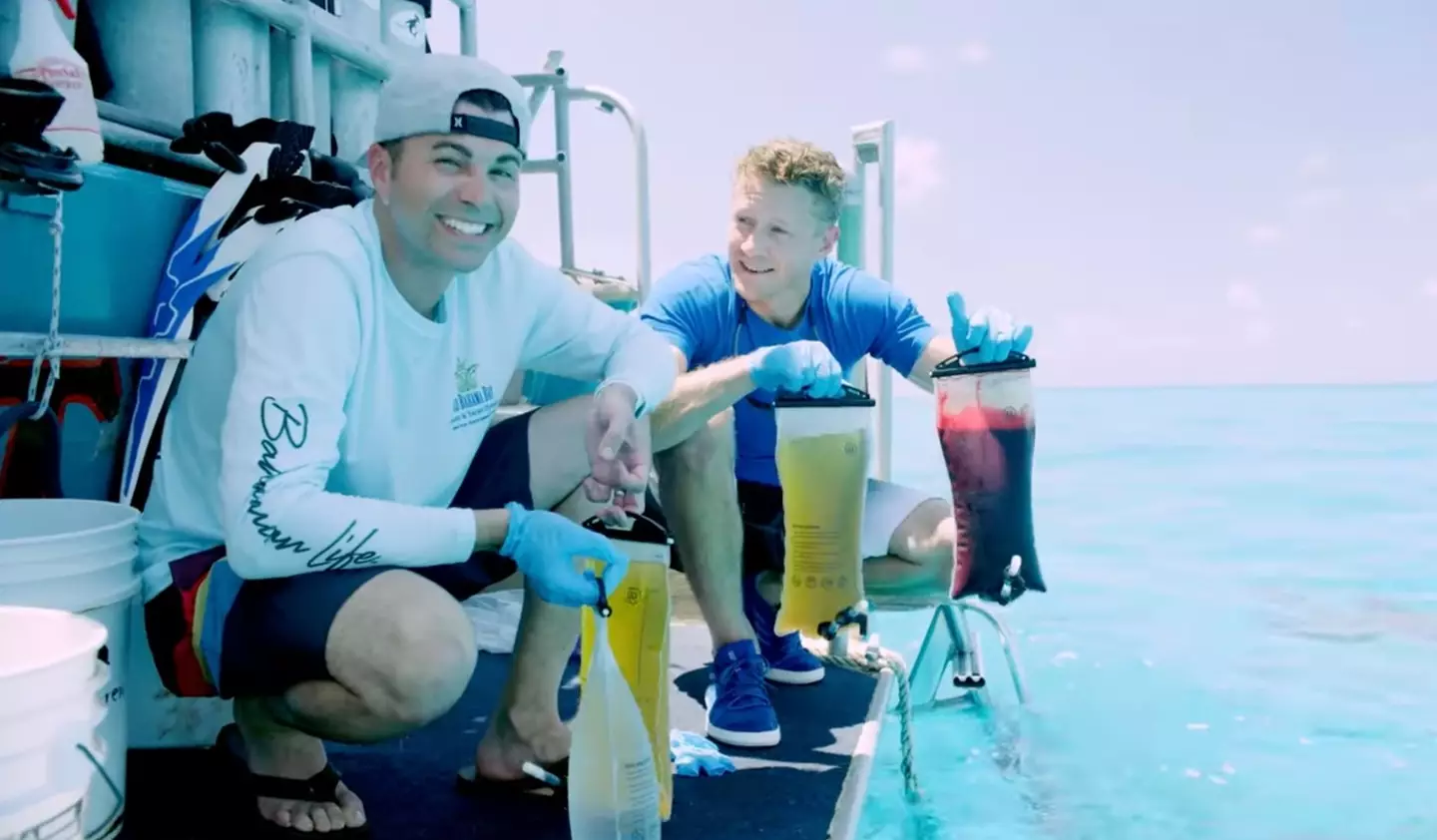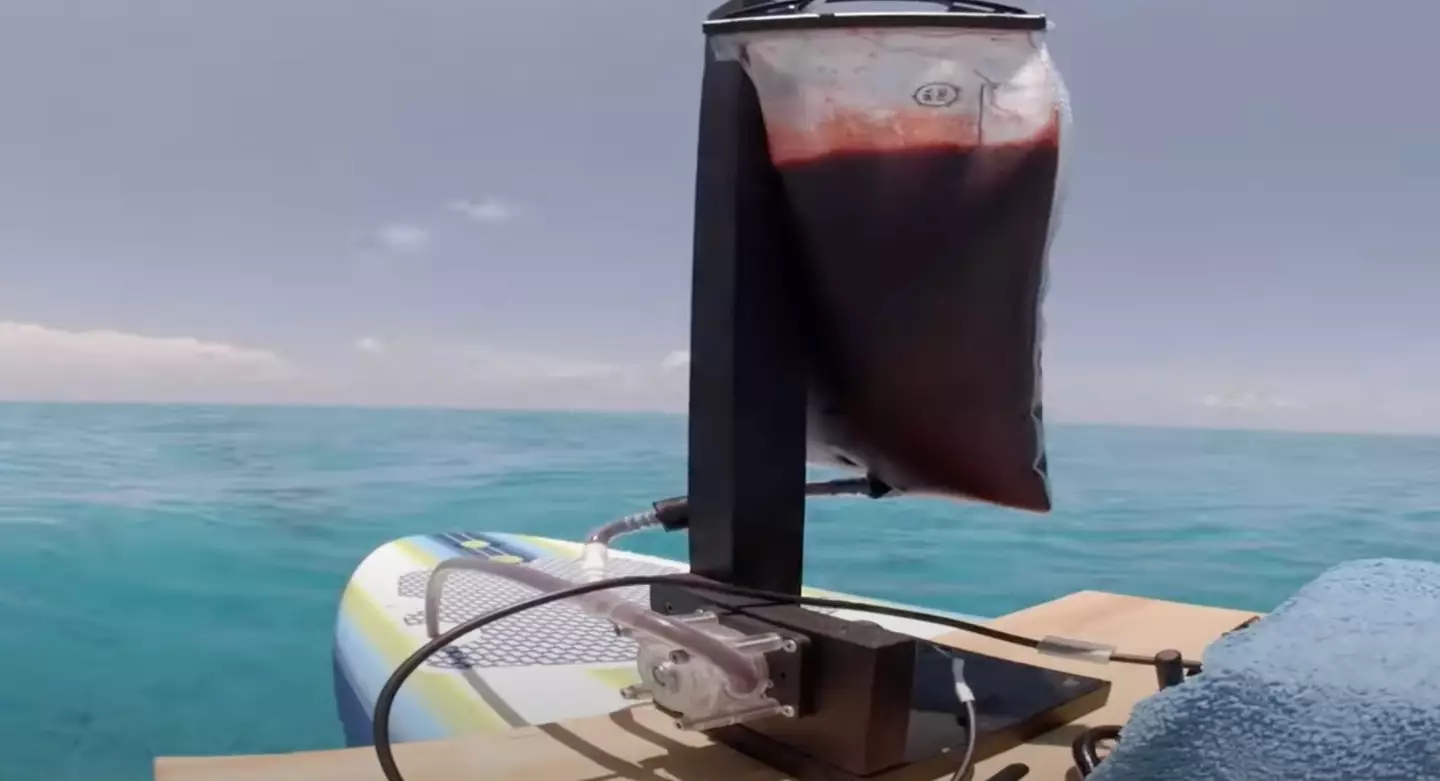Ever since watching Finding Nemo for the first time and seeing Bruce the great white shark lose all self control when he sniffed a droplet of Dory’s blood, a lot of film fans have taken the Pixar film as gospel.
We’ve been taught that the fearsome predators can smell the red stuff in microscopic concentrations, with many people leaving they can sniff it from one mile away.
Former NASA engineer turned YouTuber Mark Rober was also under this impression and said he has wanted to test the theory ‘for as long as he can remember’ – so in July 2019, he did just that.
The 44-year-old headed to a shark-infested spot 20 miles offshore in the Bahamas to conduct his experiment along with marine biologist and shark diving expert Luke Tipple.
Mark told fans that he had come up with a ‘robust test procedure’ and built himself some ‘NASA-grade hardware’ to get to the bottom of the age old stereotype about sharks dropping everything they are doing as soon as they smell blood.
He explained: “I planned to test just how far they could smell a single drop of blood in the water, but first, I wanted proof that they actually preferred blood over any other scent.”
Mark Rober decided to test the theory that sharks can smell a drop of blood from a mile away (YouTube/Mark Rober)
The experiment
To do this, he rigged up four surfboards to each pump out two litres of a different liquid – fish oil, cow’s blood, seawater and urine.
These fluids were pumped into the ocean over the course of an hour, while Mark and Luke watched on from their boat while taking drone footage to record how many sharks visited each board.
Showing off his complicated-looking contraption which he had created to set off the pumps in unison, he explained that it works by using a radio signal from the boat.
“Each surfboard has a waterproof receiver box that also holds the battery, a custom printed circuit board and two Arduinos,” the inventor said.
“Then I have the remote control and as soon as I hit this button, they all start pumping at the same time.”

He wanted to see if the predators would be more attracted to fish oil, urine, seawater or cow’s blood (YouTube/Mark Rober)
Results
The first ten minutes went buy without a lot of action near any of the boards – which Mark said was quite reassuring for people who worry about suddenly starting to bleed in the ocean or fear peeing in a wetsuit might attract sharks.
He observed: “So far it’s pretty interesting, we’ve shown that if you have a massive cut and your bleeding out, and there’s this many sharks within like 50 yards of you, they’re kind of like, ‘Meh’. Already an interesting finding, right?
“You’d think a little bit of blood and there’d just be a massive swarm, but that’s not the case so far.”
Activity seemed to pick up after the 20 minute mark, although the beasts didn’t exactly flock to the boards.
At the end of the experiment, the team found that four sharks went to check out the fish oil, zero bothered with the seawater or urine, but the blood board had a direct visit from a whopping 41 sharks.
Mark continued: “Now that we’ve debunked some surfing myths about urine and proved that sharks certainly have a strong preference for blood over anything we tested, the real question is, just how much blood is interesting to them?”

The former NASA engineer then used human blood for the second phase of the experiment (YouTube/Mark Rober)
Phase two
For the second phase of his elaborate test, Rober ended up getting a local phlebotomist on board to extract blood from himself and other members of the crew rather than using some from a cow again.
Four bulging bags were then attached to two boards in a similar setup as the initial study, while seawater was again placed in the middle of them to act as a control group.
“The board on left would pump the human blood slowly at one drop a minute, the right would pump the blood fast, on average one drop every four seconds,” Mark explained.
He pointed out that although the speedy pump might sound like a lot, it is ’40 times less’ than the amount of blood deployed during the first experiment.
Findings
Discussing his findings, the ex-product designer at Apple said: “Over the course of an hour, zero sharks checked out the control board, zero sharks checked out the slow blood pumping board and exactly zero sharks checked out the fast one.
“This was by no means a perfect experiment, but I think it’s safe to qualitatively say that if no sharks came to check out 15 drops of human blood a minute, in the middle of shark infested waters, you’re probably going to be OK with a small scrape.
“I mean, there certainly won’t be some kind of feeding frenzy with a single drop of blood from all sharks within a mile.”
So there you have it – Finding Nemo was telling fibs after all.
Featured Image Credit: YouTube/Mark Rober
Topics: Shark Attacks, Sharks, Animals, Science, World News

Laura Adams is a tech enthusiast residing in the UK. Her articles cover the latest technological innovations, from AI to consumer gadgets, providing readers with a glimpse into the future of technology.








